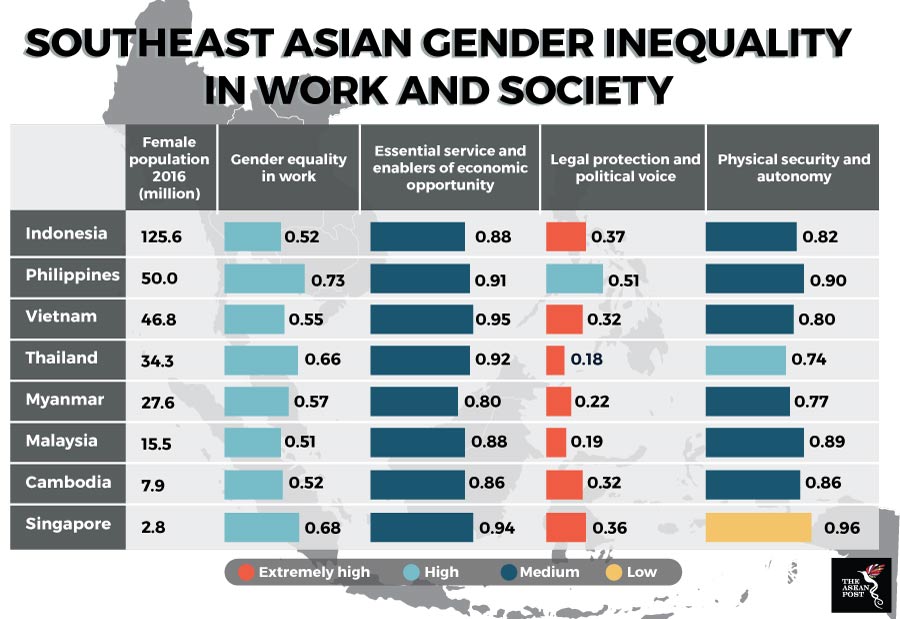The cost of gender inequality
The Cambodian government is building a global textile industry on the backs of Cambodian women working the sewing machines on the garment factory floor. However, they are often overworked and underpaid, and rarely ever promoted to supervisory positions. A study by Care International revealed that one in three Cambodian women working in the industry has suffered sexual harassment on the factory floor. Another study by the Better Factory Cambodia revealed that 15 percent of employers did not pay their female workers correctly for maternity leave and 38 percent did not allow paid time off for breastfeeding as required by law. Bullied, harassed and subjected to humiliating treatment, productive Cambodian women continue to carry the burden of the nation’s aspirations on their shoulders.
In Vietnam, women constitute the majority of the jobless, making up over 57 percent of untrained, unemployed adults. A study by a network for migrant workers set up by Oxfam, M.net, found that for the groups of vocationally trained workers and bachelor’s degree holders, the figures stand at 50 percent and 55 percent, respectively. Another study by the International Labour Organization (ILO) and Navigos Search found that of 12,300 online job advertisements, one-fifth included gender requirements, of which 70 percent preferred male candidates. Men were most often targeted for highly professional or technical jobs or jobs requiring much travelling, while women were expected to perform office and clerical jobs.
This is Southeast Asia, home to some of the world’s fastest expanding economies. Its combined economy grew to US$2.6 trillion in 2016, about the size of the United Kingdom’s (UK), and is the third fastest growing major Asian economy bloc after China and India. In the last few decades, the region has grown from strength to strength, transforming itself from a poverty-ridden agrarian backwater to one of the most dynamic and diverse emerging markets in the world. Despite these achievements in a region with more than 640 million people, gender inequality still prevails at the workplace and in society.
According to ‘The Power of Parity: Advancing Women’s Equality in Asia Pacific’ report released in April 2018 by McKinsey Global Institute, the economies of Southeast Asia could boost their collective gross domestic product (GDP) by US$370 billion a year by 2025 if the existing inequity between the genders is eliminated.
This amount, almost the size of the United Arab Emirates’ GDP in 2017, represents about a nine percent increase over the business-as-usual GDP. It could be generated by raising the female-to-male labour-force participation ratio, increasing the number of paid hours that women work, and employing more women in higher-productivity sectors. The report’s analysis did not include Brunei and Lao PDR.
Southeast Asian women contributed 36.4 percent of the combined regional GDP. However, this percentage failed to capture the total welfare and economic activity of women in the region, which also includes the very significant economic value that women create through unpaid care work in the home such as looking after children and the elderly, shopping, cooking, and cleaning. The report suggested further investigation on the mechanism to increase participation of women who are involved in unpaid work, including reducing the hours in, redistribution of, or marketisation of unpaid work.
In the work environment, as a region, Southeast Asia recorded a high level of gender inequality, with the highest recorded in Malaysia and the lowest in the Philippines. However, efforts to advance gender equality in the work environment is not likely to be achieved without progress on gender equality in society.

Source: McKinsey Global Institute.
In terms of essential services and enablers of economic opportunity, all countries recorded medium levels of gender inequality, with the highest inequality recorded in Myanmar and the lowest in Vietnam. This is almost similar to the region’s levels of gender inequality in physical security and autonomy, with the exception of Thailand which recorded a high level of inequality, and Singapore which achieved a low level of inequality. In terms of legal protection and political voice, all countries recorded extremely high levels of inequality, except for the Philippines. The highest inequality was recorded in Thailand.
The report was on point when it equated trying to grow without enabling the full potential of women to fighting with one hand tied behind one’s back. Women make up almost half of the population. As it is, Southeast Asia is already a powerful engine of growth. Imagine what the region can achieve if the other half of its population is enabled and empowered.
Source: https://theaseanpost.com/article/cost-gender-inequality


 Thailand
Thailand




